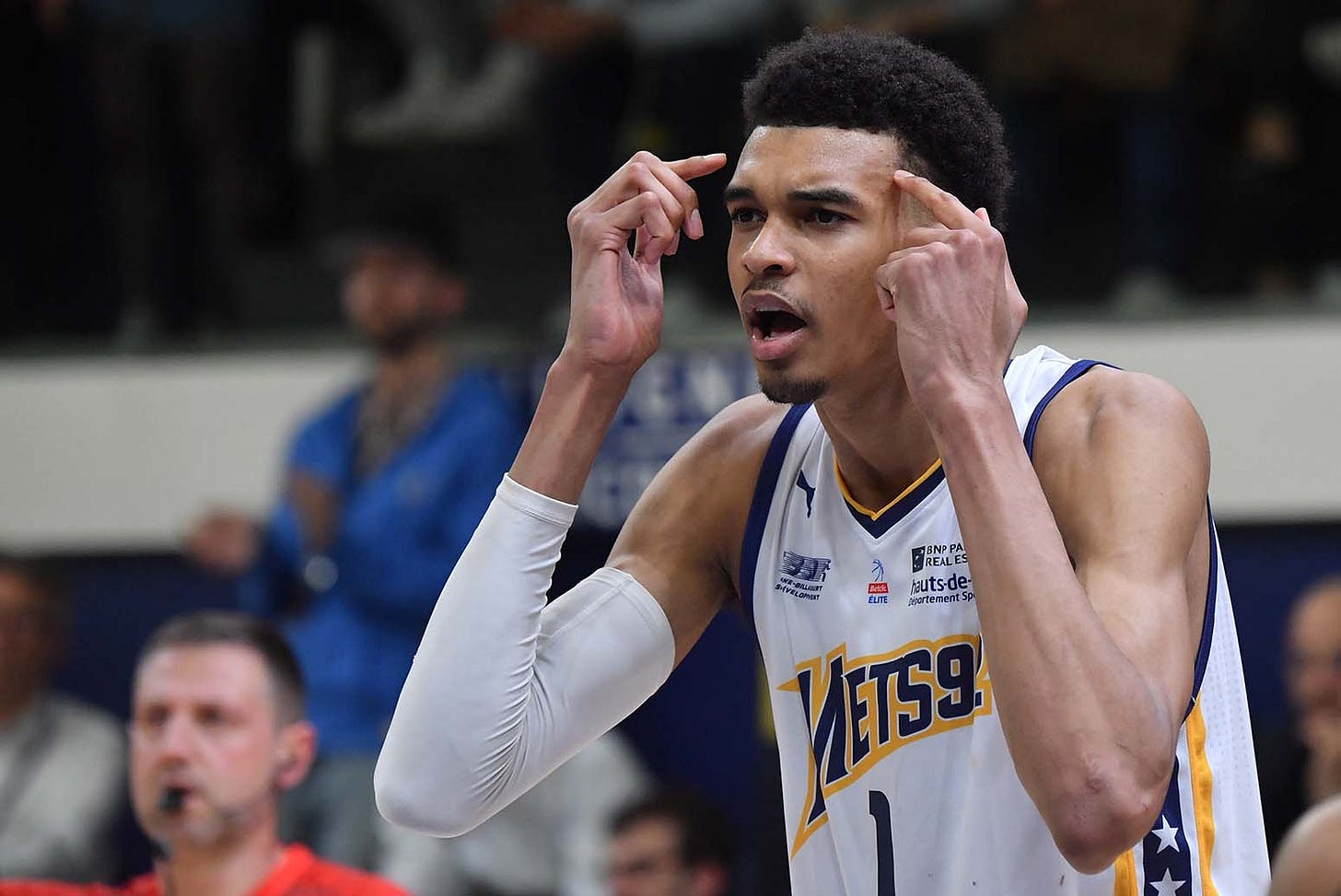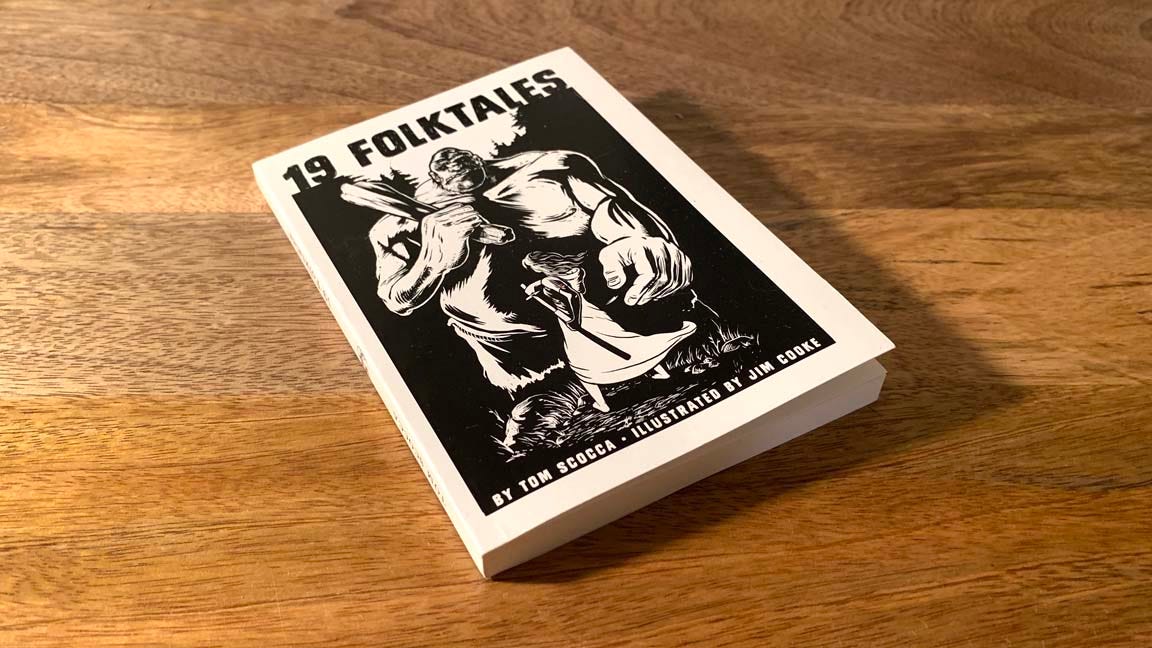
Start the NBA Draft Immediately After the NBA Draft Lottery
I ONLY WATCHED about 15 seconds of the NBA draft lottery last night, the decisive 15 seconds. That's more than I usually watch, but the winner of this lottery was going to get the rights to Victor Wembanyama. Wembanyama is an agile seven-foot-four (or maybe seven-foot-five) French teenager with grown-up ball-handling skills and scoring moves from all over the floor, on top of the overwhelming advantages in rebounding and shot-blocking that inherently come with being an agile seven-foot-four (or -five). Actually, that's an understatement; Wembanyama is hailed as an unusually gifted shot-blocker even for someone of his height, which is the height at which other people have made NBA careers based on nothing but blocking shots. His highlight plays can be laugh-out-loud funny in the same way that highlights from LeBron James or Nikola Jokic are funny: years of watching basketball have established the basic limits of what a person might do with a basketball on a basketball court, and here is someone doing something beyond those limits. The Athletic's scouting report on Wembanyama concluded, "It is actually somewhat easy to envision Wembanyama’s upside as being the best player on planet Earth someday."
And he's 19!
So it seemed worth taking part in the anticipation. Last year, I didn't care who was going to draft [quickly Googles] Paolo Banchero—oh, right, the Orlando Magic, he did great—but Wembanyama was a special occasion. I would have watched even more than I did, but when I logged into the stream, it was playing a long commercial break and I got bored and started doing something else.
They used to just do the draft lottery at halftime of a playoff game. That seemed like plenty; it was how they did the first and most famous draft lottery of all, for the rights to Patrick Ewing, with then-Commissioner David Stern pulling big envelopes with team-logo cards in them out of a hopper, in a possibly rigged draw. Now the lottery is a whole standalone TV special, even though the actual lottery part—a complicated multi-stage weighted drawing with ping pong balls, based on the teams' win-loss records—happens backstage with no cameras. The TV show is just a slow countdown announcing the results.
What exactly they padded the minutes with, I don't know, because by the time I remembered to look at the stream again, it was all but over: the Portland Trail Blazers had already been named as having the No. 3 pick, and there were only two unassigned slots left, for the Charlotte Hornets and the San Antonio Spurs. No sooner had I grasped the situation than the deputy commissioner brandished a card with the Hornets' logo, a gesture that looked like Charlotte winning something but actually meant losing, and the Spurs' representative let out a whoop, and everyone watching with no personal rooting interest let out a mordant chortle, because the Spurs are somehow, ridiculously, undefeated at winning seven-foot-tall consensus No. 1 talents in the lottery, from David Robinson through Tim Duncan to now Wembanyama.
But that was it, the show had been built around one question, and the question was answered, and all that anticipation had nowhere to go—not even to the second half of a live playoff game. The draft order was determined, and now there was more than a month to kill before the draft itself. Why couldn't the NBA's Victor Wembanyama era begin right away?
What if it could, though? What instead of making the draft lottery its own program, the NBA just combined it with the draft? As soon as the Spurs came up on top, they could have turned Wembanyama from the presumptive No. 1 to the actual No. 1, putting a San Antonio cap on his head and having him shake hands with the commissioner.
And then the distraught Hornets would have had five minutes to pull themselves together and remember that G League guard Scoot Henderson was the undisputed second-favorite prospect in the pool, and make him the No. 2 pick—or panic and grab someone else. Then Portland would be on the clock. Instead of protracted speculation about whether to trade the No. 3 pick to get help for Damian Lillard, or to trade Damian Lilllard and rebuild around the No. 3 pick, they'd have five minutes to decide.
The NBA draft, as currently set up, is a set of thin, drawn-out activities in the shadow of the playoffs. There's the combine, which is apparently going on right now, sandwiched around the lottery. There are the mock drafts and trade rumors and maybe some actual trades. Why bother?
The NFL makes a whole overwhelming production out of its draft season—in inverse proportion to how useful a draft pick is in pro football, where the majority of prospects will never see a game, let alone make a meaningful difference in one. But NFL football is a pageant of domineering managerialism, a series of bombastic committee meetings occasionally and briefly interrupted by people running around, upon which another committee does a legal and factual review of how they ran around.
Basketball is the sport of free-flowing decision making, action and reaction, shots taken and missed and taken again. Why not let the management be part of that, too? Give a front office time to consider its plans and you end up with the dysfunctional, now-dispersed Big Three of the Brooklyn Nets. Get the executives off and running—straight from the combine to the ping pong balls, and from the ping pong balls to the roster—and see what happens. Will they make catastrophic mistakes under pressure? The draft is already a cascade of catastrophic mistakes. Make the mistakes more entertaining!
MARKETING DEP'T.
WEATHER REVIEWS
New York City, May 16, 2023
★★★★ Pale green dogwood flowers spread out to face the zenith, bathed in the extra green reflecting off the leaves around them in the back courtyard. The morning and midday light seemed limitless, but the clouds thickened up into the afternoon, even as the air remained as mild as a warm bath. Children had climbed up a chain-link fence en masse, to get a better look out at something on the part of the playground below. People in Morningside Park were setting up a folding table and a grill; a few yards on, a man slept curled on his side, barefoot and shirtless on the grass, with his boots standing upright alongside him. A dog walker with seven dogs spread out came by, and then two strollers abreast, each with four toddlers in it. A robin bobbed in and out of view through unmown grass and vegetation taller than its head. Long dangling racemes of white flowers spilled forth all over a Kentucky yellowwood, swaying in the breeze. Over the ballfield the clouds were just thick enough to scatter the sun till the whole sky was painful to look at. The air turned stagnant for a spell, then wind gusted. Everything was unsettled and uncertain, but pleasant even so.
EASY LISTENING DEP’T.
SANDWICH RECIPES DEP’T.
WE PRESENT INSTRUCTIONS for the assembly of sandwiches from More Recipes for Fifty, by Frances Lowe Smith, published in 1921, found in the public domain and available at archive.org for the delectation of all.
ENGLISH SANDWICHES
Cover one slice of buttered bread with thinly sliced or grated cheese; spread second slice with orange marmalade. Put slices together, and toast on each side. The butter may be omitted.
CHICKEN SANDWICHES
Mix finely chopped chicken with Mayonnaise Dressing to moisten well; add finely chopped green pepper, or celery if desired. Put between two slices of well-buttered bread.
If you decide to prepare and attempt to enjoy a sandwich inspired by this offering, kindly send a picture to us at indignity@indignity.net.
Thanks for reading INDIGNITY, a general-interest publication for a discerning and self-selected audience. We depend on your support!







